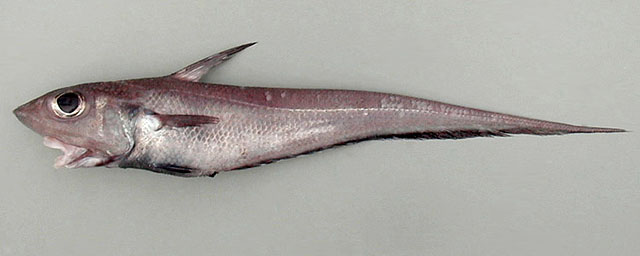| Macrouridae (Grenadiers or rattails) |
| 48 cm TL (male/unsexed); max. reported age: 10 years |
|
benthopelagic; marine; depth range 90 - 1485 m, non-migratory |
| Northeast Atlantic and Mediterranean Sea. A loose sort of southern limit for Caelorinchus caelorhincus caelorhincus is probably around Cape Verde; most specimens south and to the east into the Gulf of Guinea are likely to be Caelorinchus caelorhincus geronimoi (Iwamoto 1997, pers. Comm.). Northwest Atlantic: Canada (Ref. 5951). |
|
Dorsal spines (total): 0-0; Anal spines: 0-0. Eyes large; snout short, moderately pointed, its anterolateral margin incompletely supported by bone. Head ridges strong but with rather fine spinules; terminal snout scute trifid, wider than long, small and blunt to large and pointed, with a terminal and two lateral arms of about equal size. Underside of the snout naked medially. Light organ large, a black naked fossa between and slightly anterior to the pelvic fin bases. Overall color is pale grayish-brown to swarthy, with a series of broad saddle marks in some; oral cavity pale to dark (Ref. 1371). Spiny fin ray of first dorsal fin with a smooth and rounded leading edge (Ref. 35388). |
| Found commonly in about 200-500 m. Feeds on a variety of benthic organisms, such as polychaetes, gastropods, cephalopods, numerous crustacean groups (copepods, gammarians, isopods, cumaceans, Natantia) and fish. Minimum depth range taken from Ref. 1371. |
|
Least Concern (LC); Date assessed: 14 May 2013 Ref. (130435)
|
| harmless |
Source and more info: www.fishbase.org. For personal, classroom, and other internal use only. Not for publication.
